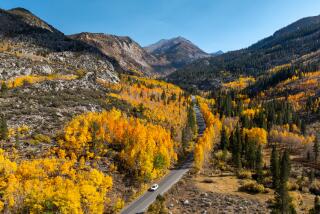Take a Hike : Fall a Great Time to Camp, Walk Near Warner Springs
While most of the nation prepares for four or five months of shivering, Southern Californians can look forward to several months of mostly sunny skies and cool, invigorating temperatures. For hikers in the know, fall is the beginning, not the end, of the finest season to explore San Diego County’s varied backcountry. Among the interesting choices is a remote section of the Cleveland National Forest in the foothills above the resort community of Warner Springs.
You should allow about 1 to 1 1/2 hours to get to Warner Springs from North County, plus a little extra driving for the two trips described below. First take California 76 or 78 to California 79. North on 79 takes you to diminutive Warner Springs. The second trip involves some dirt-road driving beyond that.
Indian Flats Campground
Indian Flats’ rather spartan facilities include drinking water, restrooms, fire rings (bring your own wood), oak-shaded campsites for cars or camper trucks, and an intriguing landscape of boulder-stacked hills.
All of this adds up to a great spot for introducing your small child to the pleasures of overnight camping, and some easy daytime hiking as well.
Within a month, nighttime temperatures may drop to freezing or below, so you will want to have a cozy tent and sleeping-bags. On at least a couple of occasions this winter, light snow should visit the campground’s 3,600-foot altitude.
This no-reservation campground can fill up on the weekends, even at this time of year, so get an early start on Friday to ensure yourself a spot. From Warner Springs, continue west (generally northbound) on California 79 1.6 miles to Indian Flatsa Road on the right.
The 6.5-mile stretch of this road leading to the campground is narrow, partly oiled and partly dirt, and normally suitable for all vehicles when driven carefully. You’d best use a truck or 4-wheel drive vehicle if it’s recently rained or snowed, though. (Call Cleveland National Forest, 788-0250, for the latest on road conditions or camping.)
A 10-minute walk past the west end of the campground takes you down past sculptured granite slabs and boulders (perfect for young scramblers) to the bank of the East Fork San Luis Rey River. By turning, upstream, you’ll very quickly reach a spot where the water, when it’s flowing, twists and turns through an impressive obstacle course of boulders.
Agua Caliente Creek
Until about 15 years ago, the canyon of Agua Caliente Creek seldom saw the intrusion of humans. After the Pacific Crest Trail was routed through, it became popular as a camping spot for hikers heading north or south.
This is one of only four places in San Diego County where the Pacific Coast Trail dips to cross a fairly dependable stream, and the only place where that trail closely follows water for a fair distance. Early this month, the creek merely trickled, but the first good rains of fall or winter will restore much of its bubbly exuberance. The best part of the hike doesn’t start until you’ve gone about 3 miles in, so plan on a half-day’s hike--8 miles or so--depending on where you decide to turn back.
Begin at the Agua Caliente Creek bridge at mile 36.6 on California 79 (1.3 miles west of Warner Springs). There’s a turnout for parking just west (mile 36.7) and a dirt road slanting over to where the trail crosses under the highway. Proceed upstream along the cottonwood-shaded creek, first on the left (north) bank, then on the right.
In this first mile, the trail goes through Warner Ranch resort property on an easement. Near the Cleveland National Forest boundary (trail camping is allowed past this point), water flows or trickles from a canyon mouth. The trail detours the rough section of canyon ahead by swinging to the east and climbing moderately onto gentle slopes covered with soft-looking ribbonwood chaparral. Stay left at a trail junction another mile ahead. After another (third) mile of somewhat tedious twisting and turning in the chaparral, you end up returning to the creek.
Ahead lies an appealing stretch of twisting canyon bottom, lined with live oaks, sycamores and willows, the latter two showing off some autumn color.
Sometimes the trail (which is not well maintained on this stretch at the moment), sticks to the vegetation-choked creek bank; otherwise it’s up on slope to avoid the rockier stretches of the canyon bottom. After crossing the creek a final time, the trail doubles back and begins a switchbacking ascent northwest toward Indian Flats Road. That’s a good spot to turn around and return the same way you came.
More to Read
Sign up for The Wild
We’ll help you find the best places to hike, bike and run, as well as the perfect silent spots for meditation and yoga.
You may occasionally receive promotional content from the Los Angeles Times.






